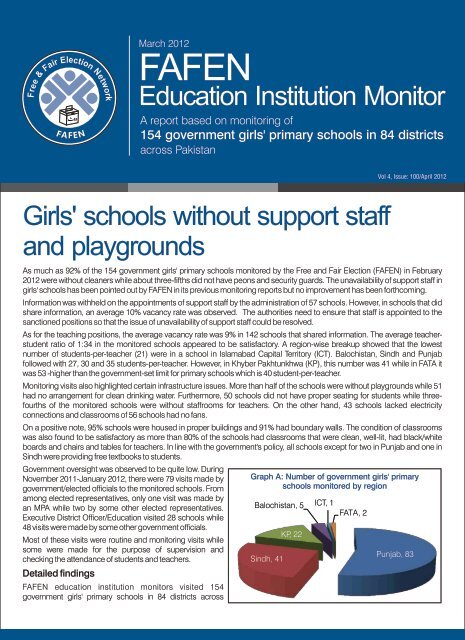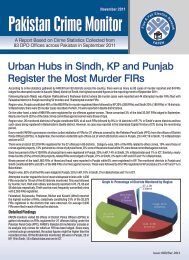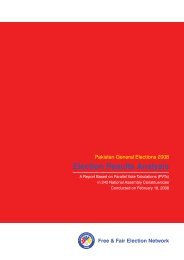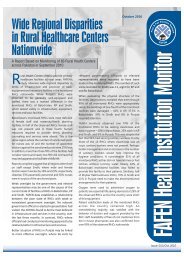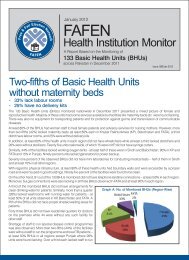177_FAFEN EIM March 12.pdf
177_FAFEN EIM March 12.pdf
177_FAFEN EIM March 12.pdf
Create successful ePaper yourself
Turn your PDF publications into a flip-book with our unique Google optimized e-Paper software.
&<br />
e<br />
re<br />
F<br />
r<br />
i<br />
Fa<br />
Electi<br />
FA<br />
FE<br />
o<br />
N<br />
n<br />
Ne<br />
tw<br />
o<br />
rk<br />
<strong>March</strong> 2012<br />
<strong>FAFEN</strong><br />
Education Institution Monitor<br />
A report based on monitoring of<br />
154 government girls' primary schools in 84 districts<br />
across Pakistan<br />
Vol 4, Issue: 100/April 2012<br />
Girls' schools without support staff<br />
and playgrounds<br />
As much as 92% of the 154 government girls' primary schools monitored by the Free and Fair Election (<strong>FAFEN</strong>) in February<br />
2012 were without cleaners while about three-fifths did not have peons and security guards. The unavailability of support staff in<br />
girls' schools has been pointed out by <strong>FAFEN</strong> in its previous monitoring reports but no improvement has been forthcoming.<br />
Information was withheld on the appointments of support staff by the administration of 57 schools. However, in schools that did<br />
share information, an average 10% vacancy rate was observed. The authorities need to ensure that staff is appointed to the<br />
sanctioned positions so that the issue of unavailability of support staff could be resolved.<br />
As for the teaching positions, the average vacancy rate was 9% in 142 schools that shared information. The average teacherstudent<br />
ratio of 1:34 in the monitored schools appeared to be satisfactory. A region-wise breakup showed that the lowest<br />
number of students-per-teacher (21) were in a school in Islamabad Capital Territory (ICT). Balochistan, Sindh and Punjab<br />
followed with 27, 30 and 35 students-per-teacher. However, in Khyber Pakhtunkhwa (KP), this number was 41 while in FATA it<br />
was 53 -higher than the government-set limit for primary schools which is 40 student-per-teacher.<br />
Monitoring visits also highlighted certain infrastructure issues. More than half of the schools were without playgrounds while 51<br />
had no arrangement for clean drinking water. Furthermore, 50 schools did not have proper seating for students while threefourths<br />
of the monitored schools were without staffrooms for teachers. On the other hand, 43 schools lacked electricity<br />
connections and classrooms of 56 schools had no fans.<br />
On a positive note, 95% schools were housed in proper buildings and 91% had boundary walls. The condition of classrooms<br />
was also found to be satisfactory as more than 80% of the schools had classrooms that were clean, well-lit, had black/white<br />
boards and chairs and tables for teachers. In line with the government's policy, all schools except for two in Punjab and one in<br />
Sindh were providing free textbooks to students.<br />
Government oversight was observed to be quite low. During<br />
November 2011-January 2012, there were 79 visits made by<br />
government/elected officials to the monitored schools. From<br />
among elected representatives, only one visit was made by<br />
an MPA while two by some other elected representatives.<br />
Executive District Officer/Education visited 28 schools while<br />
48 visits were made by some other government officials.<br />
Most of these visits were routine and monitoring visits while<br />
some were made for the purpose of supervision and<br />
checking the attendance of students and teachers.<br />
Detailed findings<br />
<strong>FAFEN</strong> education institution monitors visited 154<br />
government girls' primary schools in 84 districts across<br />
Graph A: Number of government girls' primary<br />
schools monitored by region<br />
Balochistan, 5<br />
Sindh, 41<br />
KP, 22<br />
ICT, 1<br />
FATA, 2<br />
Punjab, 83
Pakistan. Of these, 83 schools were monitored in 35 districts in Punjab, 41 in 26 districts in Sindh, 22 in 15 KP districts, five in as<br />
many districts in Balochistan, two in as many agencies in FATA and one in ICT.<br />
1. Appointments of teaching staff<br />
Of the 154 schools monitored, 142 provided information on the appointments of teachers. However, six schools in Sindh, five in<br />
Punjab and one in KP withheld this information.<br />
In schools that did share information, the average vacancy rate was 9% - 729 positions occupied out of 798.<br />
A region-wise analysis showed that all the sanctioned teaching positions in schools in Balochistan and FATA were filled.<br />
However, of the 277 posts in schools monitored in Sindh, 236 were occupied leaving 15% vacant. Similarly, 7% positions lay<br />
vacant in Punjab and 2% in KP. Of the eight sanctioned positions in a school in ICT, seven were occupied.<br />
S. # Province<br />
Number of sanctioned<br />
teaching positions<br />
Number of teachers<br />
posted in the school<br />
Vacant teaching<br />
positions (%)<br />
Number of schools<br />
sharing information<br />
1. Punjab 336 312 7.14 78<br />
2. Sindh 277 236 14.80 35<br />
3. KP 143 140 2.10 21<br />
4. Balochistan 29 29 0.00 5<br />
5. ICT 8 7 12.50 1<br />
6. FATA 5 5 0.00 2<br />
Total 798 729 8.65 142<br />
2. Appointments of non-teaching staff<br />
Fifty seven schools withheld information on the appointments of non-teaching staff. As many as 151 positions were sanctioned<br />
of which 136 were occupied in schools that provided information on these appointments.<br />
Monitoring Methodology<br />
The Free and Fair Election Network (<strong>FAFEN</strong>) has launched a nationwide initiative to monitor governance processes under its<br />
Supporting Transparency Accountability and Electoral Processes (STAEP) as part of its mandate to strengthen all forms of democratic<br />
accountabilities in Pakistan. Objective information about governance processes is vital to encourage informed engagement of<br />
citizenry with elected and public institutions for progressive outputs. <strong>FAFEN</strong> Governance Monitoring aims at enriching the public<br />
discourse and debate on governance and developing research-based recommendations for reforms.<br />
<strong>FAFEN</strong> advocates for transparency, accountability, responsiveness, representativeness and public participation as essential<br />
elements of democratic governance to enhance the output, efficiency and effectiveness of all elected and public institutions.<br />
<strong>FAFEN</strong> Governance Monitors visit schools and colleges, heath facilities, police stations and other public institutions to monitor and<br />
evaluate their efficiency and efficacy in 200 National Assembly constituencies of 119 districts in Punjab, Khyber Pakhtunkhwa,<br />
Balochistan, Sindh, Federally Administered Tribal Areas (FATA) and Islamabad Capital Territory (ICT). In addition, <strong>FAFEN</strong> is also<br />
monitoring complaints handling mechanisms of various public institutions to gauge their effectiveness.<br />
Trained <strong>FAFEN</strong> Governance Monitors fill out standardized checklists during their monitoring visits, employing interviewing and<br />
observation techniques, and then transmit the data to the <strong>FAFEN</strong> Secretariat in Islamabad for data entry, cleaning and analysis.<br />
<strong>FAFEN</strong> plans to produce monthly thematic reports such as this one. This information will also contribute to <strong>FAFEN</strong> Bi-Annual State of<br />
Governance in Pakistan Reports.<br />
<strong>FAFEN</strong> Governance Monitoring reports are based on non-probability sampling, and their findings should not be considered national<br />
or provincial generalizations. However, <strong>FAFEN</strong>'s outreach across the country allows it to access most districts as well as urban and<br />
rural areas. Standardized methodology is applied across Pakistan to draw information in a uniform way through observation and<br />
interviewing. The observation and interviews are recorded on a standardized checklist. All information received at the <strong>FAFEN</strong><br />
Secretariat is verified through multiple sources for authenticity and accuracy. These reports provide data analysis and inferences only<br />
for the monitored institutions within the sample. These reports are meant to present to relevant stakeholders a consolidated and<br />
current snapshot of the state of governance in public institutions in order to inspire public dialogue and as a contribution towards<br />
targeted interventions and reforms.<br />
However, <strong>FAFEN</strong>'s unique methodology to assess and evaluate governance processes continues to evolve. Any inaccuracies that<br />
may be noticed in the data or suggestions for improvement in the methodology can be sent to the email address at the end of this<br />
report.<br />
2
w w w . f a f e n . o r g<br />
Looking at a region-wise breakup, all the sanctioned positions in schools in Balochistan, ICT and FATA were filled. However, in<br />
Sindh 20% of the sanctioned posts were vacant, followed by 6% in KP and 5% in Punjab.<br />
S. # Province<br />
3. Availability of support staff<br />
Unavailability of support staff was observed in the monitored schools. It was found that 96 schools - 60 in Punjab, 18 in Sindh,<br />
14 in KP and four in Balochistan - did not have peons while 94 schools, of which 56 were in Punjab, 27 in Sindh, five in KP, four in<br />
Balochistan and two in FATA – did not have security guards.<br />
Similarly, 92% of the monitored schools had no cleaners. Only six schools in Punjab, three in KP, two in Sindh and one in ICT<br />
had them.<br />
4. Teacher-student ratio<br />
Number of sanctioned<br />
positions for non-teaching<br />
staff<br />
Number of non-teaching<br />
staff posted in the school<br />
Vacant nonteaching<br />
positions<br />
(%)<br />
Number of schools<br />
sharing information<br />
1 Punjab 57 54 5.26 44<br />
2 Sindh 51 41 19.61 28<br />
3 KP 32 30 6.25 21<br />
4 Balochistan 2 2 0.00 1<br />
5 ICT 7 7 0.00 1<br />
6 FATA 2 2 0.00 2<br />
Total 151 136 9.93 97<br />
As many as 802 teachers were appointed and 27,179 students enrolled in the 154 schools monitored. The average teacherstudent<br />
ratio came out to be 1:34.<br />
Region-wise statistics show the lowest number of students-per-teacher (21) was observed in a school in ICT. Balochistan,<br />
Sindh and Punjab followed with 27, 30 and 35 students-per-teacher. However, the number of students-per-teacher in schools in<br />
KP and FATA was quite high. In KP, 5,901 students were enrolled and 145 teachers appointed, making the teacher-student ratio<br />
stand at 1:41. Similarly, 263 students were enrolled and only five teachers appointed in the two schools monitored in FATA. The<br />
teacher-student ratio in the region was 1:53.<br />
S.<br />
#<br />
S. # Support staff Province Punjab Sindh KP Balochistan ICT FATA Total<br />
1. The school has peon<br />
2. The school has security guard<br />
3. The school has cleaner<br />
Province<br />
Number of<br />
schools<br />
Yes 23 23 8 1 1 2 58<br />
No 60 18 14 4 0 0 96<br />
Yes 27 14 17 1 1 0 60<br />
No 56 27 5 4 0 2 94<br />
Yes 6 2 3 0 1 0 12<br />
No 77 39 19 5 0 2 142<br />
Teachers posted in the<br />
school<br />
Students enrolled in the<br />
school<br />
Number of students per<br />
teacher<br />
1. Punjab 83 312 10822 35<br />
2. Sindh 41 303 9235 30<br />
3. KP 22 145 5901 41<br />
4. Balochistan 5 30 808 27<br />
5. ICT 1 7 150 21<br />
6. FATA 2 5 263 53<br />
Total 154 802 27179 34<br />
5. Physical infrastructure<br />
Ninety five percent of the schools monitored were housed in buildings and 91% had boundary walls. The condition of<br />
classrooms was also satisfactory - four-fifths of the classrooms being clean, well-lit, having black/white boards and chairs and<br />
tables for teachers.<br />
However, availability of proper seating for students was not ensured in 50 schools - 25 in Punjab, 11 in KP, eight in Sindh, four in<br />
Balochistan and two in FATA.<br />
3
Furthermore, 43 schools did not have electricity connections while classrooms of 56 schools were without fans. Fifty one<br />
schools - all monitored in Balochistan and FATA, 23 in Sindh, 17 in Punjab and four in KP - did not have arrangements for clean<br />
drinking water. Though physical education is an important part of a child's development, more than half of the schools did not<br />
have playgrounds. These included 41 in Punjab, 21 in Sindh, 13 in KP, four in Balochistan and one in FATA. Three-fourths of the<br />
monitored schools did not have staffrooms for teachers. In line with the government's policy, all schools except for two in Punjab<br />
and one in Sindh were providing free textbooks to students.<br />
S. # Building and facilities Province Punjab Sindh KP Balochistan ICT FATA Total<br />
1. The classrooms are clean<br />
2. The school is housed in a building<br />
3.<br />
There is a boundary wall around the<br />
school building<br />
4. All classrooms are well- lit<br />
5.<br />
6.<br />
7.<br />
8.<br />
All classrooms have desks and<br />
benches/chairs for students<br />
All the classrooms have black/white<br />
boards<br />
Classrooms have chair and tables<br />
for teachers<br />
The school has clean drinking water<br />
arrangements for students<br />
9. The school has electricity<br />
10.<br />
11.<br />
12.<br />
13.<br />
The school has fans in all<br />
classrooms<br />
The school has playground for<br />
students<br />
The school has staffroom for<br />
teachers<br />
The school is providing free<br />
textbooks to students<br />
6. Teachers' attendance<br />
Yes 71 33 21 4 1 1 131<br />
No 12 8 1 1 0 1 23<br />
Yes 79 39 21 5 1 2 147<br />
No 4 2 1 0 0 0 7<br />
Yes 76 35 21 5 1 2 140<br />
No 7 6 1 0 0 0 14<br />
Yes 77 37 21 3 1 2 141<br />
No 6 4 1 2 0 0 13<br />
Yes 58 33 11 1 1 0 104<br />
No 25 8 11 4 0 2 50<br />
Yes 81 40 22 5 1 2 151<br />
No 2 1 0 0 0 0 3<br />
Yes 75 32 22 3 1 1 134<br />
No 8 9 0 2 0 1 20<br />
Yes 66 18 18 0 1 0 103<br />
No 17 23 4 5 0 2 51<br />
Yes 63 25 20 1 1 1 111<br />
No 20 16 2 4 0 1 43<br />
Yes 55 23 17 1 1 1 98<br />
No 28 18 5 4 0 1 56<br />
Yes 42 20 9 1 1 1 74<br />
No 41 21 13 4 0 1 80<br />
Yes 14 16 9 0 1 0 40<br />
No 69 25 13 5 0 2 114<br />
Yes 81 40 22 5 1 2 151<br />
No 2 1 0 0 0 0 3<br />
<strong>FAFEN</strong> observers noted the number of teachers present on the day of their visit to the monitored schools and found the<br />
attendance was 76% and higher in around four-fifths of them. Eighteen schools - nine in Punjab, three each in KP and Sindh,<br />
two in Balochistan and one in FATA - had attendance between 51% and 75%. The attendance was between 26% to 50% in<br />
seven schools in Punjab and one each in KP and Sindh.<br />
No teacher was posted to a school in Sindh and a volunteer was working as a teacher.<br />
S. # Percentage of teachers present Punjab Sindh KP Balochistan ICT FATA Total<br />
1. Below 25% 0 0 0 0 0 0 0<br />
2. 26% to 50% 7 1 1 0 0 0 9<br />
3. 51% to 75% 9 3 3 2 0 1 18<br />
4. 76% to 100% 67 36 18 3 1 1 126<br />
Total 83 41 22 5 1 2 153<br />
4
w w w . f a f e n . o r g<br />
7. Students' attendance<br />
Of the 154 schools, 110 had attendance of students which was above 76% on the day of <strong>FAFEN</strong> observers' visits. However,<br />
student attendance in the rest of the schools was lesser. Thirty five schools - 17 in Sindh, 14 in Punjab, three in KP and one in<br />
Balochistan - had students' attendance between 51% and 75%.<br />
The attendance was 26% to 50% in three schools in Sindh, two in Punjab and one in KP while it was below 25% in two schools in<br />
Sindh and one in KP.<br />
S. # Percentage of students present Punjab Sindh KP Balochistan ICT FATA Total<br />
1 Below 25% 0 2 1 0 0 0 3<br />
2 26% to 50% 2 3 1 0 0 0 6<br />
3 51% to 75% 14 17 3 1 0 0 35<br />
4 76% to 100% 67 19 17 4 1 2 110<br />
5 Above 100% 0 0 0 0 0 0 0<br />
Total 83 41 22 5 1 2 154<br />
8. Government oversight<br />
In the quarter November 2011-January 2012, government/elected officials made79 visits to the monitored schools. From<br />
among elected representatives, only one visit was made by an MPA while two by some other elected representatives to one<br />
school each in Punjab and Sindh. The Executive District Officer/Education visited 28 schools - 15 in Punjab, eight in KP and five<br />
in Sindh while 48 visits were made by some other government officials.<br />
Most of these visits were routine and monitoring visits while some were made for the purpose of supervision and checking the<br />
attendance of students and teachers.<br />
S. # Designation Punjab Sindh KP Balochistan FATA ICT Total<br />
1. MNA - - - - - - -<br />
2. MPA 1 - - - - - 1<br />
3. EDO/Education 15 5 8 - - - 28<br />
4. Any other government official 41 5 1 1 - - 48<br />
5. Any other elected representative 1 1 - - - - 2<br />
Total 58 11 9 1 - - 79<br />
Annexure: List of monitored government girls' primary schools<br />
S. # Name of School District Province<br />
1. Government MC Girls' Primary School, Kot Ghulam Muhammad Kasur Punjab<br />
2. Government Girls' Primary School, Jalal Kot Okara Punjab<br />
3. Government Community Model Girls' Primary School, Kamman, Renala Khurd Okara Punjab<br />
4. Government Girls' Primary School, Theh Bholay Kay Kasur Punjab<br />
5. Government Girls' Primary School, Puranay Dauke, Muridke Sheikhupura Punjab<br />
6. Government Girls' Primary School, Qila Harri Chand, Depalpur Okara Punjab<br />
7. Government Girls' Primary School, Chak No.364/TDA, Choubara Layyah Punjab<br />
8. Government Girls' Primary School, Chak Bazeed Chakwal Punjab<br />
9. Government Girls' Primary School, New Rehmanpura Changa Manga, Chunian Kasur Punjab<br />
10. Government Girls' Primary School, Nai Abadi Shumali Darya Khan Bhakkar Punjab<br />
11. Government Girls' Primary School, Kotli Peer Ahmed Shah, Aroop Town Gujranwala Punjab<br />
12. Government Girls' Primary School, Basti Arain, Jatoi Muzaffargarh Punjab<br />
13. Government Girls' Primary School, Dera Habib Shah, Shahkot Nankana Sahib Punjab<br />
14. Government Girls' Primary School, Mission Hunterpura Sialkot Punjab<br />
15. Government Girls' Primary School, Dhaknywala Muzaffargarh Punjab<br />
16. Government Girls' Primary School Bangri, Piplan Mianwali Punjab<br />
17. Government Girls' Primary School, Chak No.75/DNB, Yazman Bahawalpur Punjab<br />
18. Government Girls' Primary School No.2, Suleman Paris Jhelum Punjab<br />
19. Government Girls' Primary School, Chak No.160 Murad, Hasilpur Bahawalpur Punjab<br />
20. Government Community Model Girls' Primary School, Tahliwala Bahawalpur Punjab<br />
21. Government Girls' Primary School, Basti Khamisa Bahawalpur Punjab<br />
22. Government Girls' Primary School, Asmat Sultan, Ahmedpur Bahawalpur Punjab<br />
23. Government Girls' Primary School No.1 Narowal Punjab<br />
5
S. # Name of School District Province<br />
24. Government Primary School, Shahiwala No.2, Alipur Muzaffargarh Punjab<br />
25. Government Girls' Primary School, Mud Manthar Rahimyar Khan Punjab<br />
26. Government Girls' Primary School, Nangal Sudkan Narowal Punjab<br />
27. Government Girls' Primary School, Gulshan Altaf Irrigation Colony, Khanpur Rahimyar Khan Punjab<br />
28. Government Girls' Primary School, Mujahid Nagar Sheikhupura Punjab<br />
29. Government Girls' Primary School No.1, Chak No.88/S-B Sargodha Punjab<br />
30. Government Girls' Primary School, Chak No.36/S-P Pakpattan Punjab<br />
31. Government Girls' Primary School, Khair Ghansar, Kharian Gujrat Punjab<br />
32. Government Girls' Primary School, Kora Isra, Kabirwala Khanewal Punjab<br />
33. Government Girls' Primary School, Ratta Amral, Rawal Town Rawalpindi Punjab<br />
34. Government MC Girls' Primary School, Affandi Colony, Rawal Town Rawalpindi Punjab<br />
35. Government Girls' Primary School, Chak No.43/W-B Vehari Punjab<br />
36. Government Girls' Primary School, Moza Ali-ul-Din Vehari Punjab<br />
37. Government Aziz National Girls' Primary School, Dheri Hassanabad Rawalpindi Punjab<br />
38. Government Girls' Primary School, Chak No.18/A-H Khanewal Punjab<br />
39. Government MC Girls' Primary School No.2, Chichawatni Sahiwal Punjab<br />
40. Government Girls' Primary Shool, Ward No.5, Arifwala Pakpattan Punjab<br />
41. Government Girls' Primary School, Sonay Khalanwala Mianwali Punjab<br />
42. Government Girls' Primary School, Farooqabad, Madina Town Faisalabad Punjab<br />
43. Government Girls' Primary School, Chak No.214/R-B, Himmatpura, Madina Town Faisalabad Punjab<br />
44. Government MC Girls' Primary School No.12 Dera Ghazi Khan Punjab<br />
45. Government Girls' Primary School, Ram Kot, Minchinabad Bahawalnagar Punjab<br />
46. Government Girls' Primary School, Jughian Sialan, Ferozewala Sheikhupura Punjab<br />
47. Government Girls' Primary School, Fauji Colony, Liaqatpur Rahimyar Khan Punjab<br />
48. Government Girls' Primary School, Khichi Jageer, Shahpur Sargodha Punjab<br />
49. Government Girls' Primary School, 386/W-B No.2, Dunyapur Lodhran Punjab<br />
50. Government MC Junior Model Girls' Primary School, Khokar Pind Badami Bagh, Ravi Town Lahore Punjab<br />
51. Government MC Junior Model School, Rewaz Garden, Data Ganj Bax Town Lahore Punjab<br />
52. Government Girls' Primary School, Nishtar Town Lahore Punjab<br />
53. Government Girls' Primary School, Talal Sharaq, Talagang Chakwal Punjab<br />
54. Government Girls' Primary School, 13 Gajiani-A, Chishtian Bahawalnagar Punjab<br />
55. Government Girls' Primary School, Qadir Colony Gujrat Punjab<br />
56. Government Girls' Primary School, Mohallah Islampura Rahimyar Khan Punjab<br />
57. Government Girls' Primary School MC NO.22, Nandipur Town Gujranwala Punjab<br />
58. Government Girls' Primary School, Rappar No.1, Kehror Pacca Lodhran Punjab<br />
59. Government Girls' Primary School No.3, Jauharabad Khushab Punjab<br />
60. Government Girls' Primary School, Tarf Daira, Mumtazabad Town Multan Punjab<br />
61. Government Girls' Primary School, Bagga Pump Mandi Bahauddin Punjab<br />
62. Government Mumtaz Girls' Primary School Hafizabad Punjab<br />
63. Government Girls' Primary School, Chak No.112/P Rahimyar Khan Punjab<br />
64. Government Girls' Primary School, Basti Danwar, Jampur Rajanpur Punjab<br />
65. Government Girls' Primary School, Timber Market Sargodha Punjab<br />
66. Government Girls' Primary School, Qila Sunder Singh, Khiali Shahpur Town Gujranwala Punjab<br />
67. Government Girls' Primary School Mattlay, Daska Sialkot Punjab<br />
68. Government Girls' Primary School, Buch Khusroabad Multan Punjab<br />
69. Government Girls' Primary School, Basal No.1, Jand Attock Punjab<br />
70. Government Girls' Primary School, Kat Dharmeywali Bahawalnagar Punjab<br />
71. Government Girls' Primary School, Kot Allah Din No.2 Sahiwal Punjab<br />
72. Government MC Girls' Primary School No.15, Sahiwal Sahiwal Punjab<br />
73. Government Girls' Primary School, Purani Abadi Nankana Sahib Punjab<br />
74. Government MC Girls' Primary School, Pul Mauj Darya, Bosan Town Multan Punjab<br />
75. Government Girls' Primary School, Basti Domra, Mumtazabad Town Multan Punjab<br />
76. Government Girls' Primary School, Dhok Sawain Attock Punjab<br />
77. Government Girls' Primary School, Karim Bux Pirhar Rajanpur Punjab<br />
78. Government Girls' Primary School, Chahari Dolal, Gujar Khan Rawalpindi Punjab<br />
79. Government Girls' Primary School, Chak No.295/G-B III Jinnah Abadi Toba Tek Singh Punjab<br />
80. Government Girls' Primary School, Chak No.270 Chishtian Jhang Punjab<br />
81. Government Girls' Primary School, Farooqia Bhakkar Punjab<br />
82. Government Girls' Primary School, Chak No.220 Jhangrah Jhang Punjab<br />
83. Government Girls' Primary School, Basti Kunal Shah Habib Layyah Punjab<br />
84. Government Girls' Primary School, Nasirabad Umerkot Sindh<br />
85. Government Girls' Primary School, Nabisar Sahar, Diplo Tharparkar Sindh<br />
86. Government Girls' Primary School Thari, Talhar Badin Sindh<br />
87. Government Girls' Primary School, Main Urdu Digri Mirpurkhas Sindh<br />
88. Government Girls' Primary School, Ghulam Muhammad Noonari, Kandhkot Kashmore Sindh<br />
6
w w w . f a f e n . o r g<br />
S. # Name of School District Province<br />
89. Government Girls' Primary School, Mohammad Khan Matharo, Chachro Tharparkar Sindh<br />
90. Government Girls' Primary School, Tando Saindad Tando Mohammad Khan Sindh<br />
91. Government Girls' Primary School, Sector 5-E New Karachi Town Karachi Central Sindh<br />
92. Government Girls' Primary School, Tando Agha Lutuf Ali Shah, Hyderabad City Hyderabad Sindh<br />
93. Government Girls' Primary School, Garibabad, Hyderabad City Hyderabad Sindh<br />
94. Government Girls' Primary School, Town Committee New Karachi Town Karachi Central Sindh<br />
95. Government Girls' Primary School, Ubaro-II Ghotki Sindh<br />
96. BMB Government Girls' Primary School, Jamia Cloth, Saddar Town Karachi South Sindh<br />
97. Government Girls' Primary School, Mohammad Khan Colony, Baldia Town Karachi West Sindh<br />
98. Government Girls' Primary School, Ibrahim Shinno Dadu Sindh<br />
99. Government Girls' Primary School, Padidan Station Naushero Feroz Sindh<br />
100. Government Girls' Main Primary School, Kamber Kamber Shahdadkot Sindh<br />
101. Government Girls' Primary School, Baldia Township Karachi West Sindh<br />
102. Government Girls' Primary School No.13, Shah Faisal Colony No.5, Gulshan Town Karachi East Sindh<br />
103. Government Girls' Urdu Main Primary School Sanghar Sindh<br />
104. Government Girls' Primary School, Garden West No.1, Saddar Town Karachi South Sindh<br />
105. Government Girls' Primary School, Laique Maka, Sukkur City Sukkur Sindh<br />
106. Government Girls' Primary School, Nouraja, Pano Akil Sukkur Sindh<br />
107. Government Girls' Primary School, Noor Muhammadi, Shahdadkot Kamber Shahdadkot Sindh<br />
108. Government Girls' Primary School, Theba, Mehar Dadu Sindh<br />
109. Government Girls' Primary School, Behlar, Sobho Dero Khairpur Sindh<br />
110. Government Girls' Primary School, Sector-D Bhatti Colony, Korangi Karachi East Sindh<br />
111. Anjuman-e-Taraqi-e-Urdu Government Girls' Primary School, Mujahid Colony, Gulshan Town Karachi East Sindh<br />
112. Government Girls' Primary School, Ahmed Hussain Baloch, Ghora Bari Thatta Sindh<br />
113. Government Girls' Primary School, Orangi No.5 Karachi West Sindh<br />
114. Government Girls' Primary School, Makhdoom Saeeduzaman, Hala Matiari Sindh<br />
115. Government Girls' Primary School, Abdul Aziz Kharani Jacobabad Sindh<br />
116. Government Girls' Primary Main Sindhi School, Tando Allahyar Tando Allahyar Sindh<br />
117. Government Girls' Primary School, Hote Khan Jalbani, Mehrabpura Naushero Feroz Sindh<br />
118. Government Girls' Primary School, Razakabad, Malir Town Malir Sindh<br />
119. Government Girls' Primary School, Berari Ghotki Sindh<br />
120. Government Girls' Primary School, Khedkar Larkana Sindh<br />
121. Government Girls' Primary School, Arain, Garhi Yasin Shikarpur Sindh<br />
122. Government Girls' Primary School, Haji Eddan Sarki, Thul Jacobabad Sindh<br />
123. Government Girls' Primary School, Khurshed Colony Jamshoro Sindh<br />
124. Government Girls' Primary School, Saddar Shikarpur Sindh<br />
125. Government Girls'' Primary School, Takhtbai No.3 Mardan KP<br />
126. Government Girls'' Primary School, Bagdada No.1, Mardan Mardan KP<br />
127. Government Girls' Primary School, Behari Colony, Peshawar Town-3 Peshawar KP<br />
128. Government Girls' Primary School, Hazar Khuwani No.1, Peshawar Town-4 Peshawar KP<br />
129. Government Girls' Primary School, Dalazak Road, Peshawar Town-1 Peshawar KP<br />
130. Government Girls' Primary School, Thakot Battagram KP<br />
131. Government Girls' Primary School, City Laghri Gate Dera Ismail Khan KP<br />
132. Government Girls' Primary School, Jadid Abadi Bannu City No.3 Bannu KP<br />
133. Government Girls' Primary School, Shah Alam, Peshawar Town-2 Peshawar KP<br />
134. Government Girls' Primary School, Shakardara No.1 Kohat KP<br />
135. Government Girls' Primary School, Sheno Killla, Banda Daud Shah Karak KP<br />
136. Government Girls' Primary School, Shah Kot Bala, Pabbi Nowshehra KP<br />
137. Government Girls' Primary School, Jehangira Dheri Nowshehra KP<br />
138. Government Girls' Primary School, Khan Garhi, Dargai Malakand KP<br />
139. Government Girls' Primary School, Kaddi Swabi KP<br />
140. Government Community Model Girls' School, Panjpir Swabi KP<br />
141. Government Girls' Primary School, Wrasta Kalay Hangu KP<br />
142. Government Girls' Primary School, Jandar Kot, Dassu Kohistan KP<br />
143. Government Girls' Primary School, Cheena, Tangi Charsadda KP<br />
144. Government Girls' Primary School, Haripur No.3 Haripur KP<br />
145. Government Girls' Primary School, Toora Panra Charsadda KP<br />
146. Government Girls' Primary School, Biland Khel Lakki Marwat KP<br />
147. Government Girls' Primary School, Basti Kamal Shah, Gandawa Jhal Magsi Balochistan<br />
148. Government Girls' Primary School, Bagan Baba Colony Jaffarabad Balochistan<br />
149. Government Girls' Primary School, Jat Muhalla, Dera Murad Jamali Nasirabad Balochistan<br />
150. Government Girls' Primary School, Killi Noor Bukhsh, Dalbadin Chagai Balochistan<br />
151. Government Girls' Primary School, Killi Atta Muhammad Nushki Balochistan<br />
152. Islamabad Model School, 1-5th Islamabad ICT<br />
153. Government Girls' Primary School, Sharali Kaly, Yakka Ghund Mohmand Agency FATA<br />
154. Government Girls' Primary School, Raza Khan Killi, Jamrud Khyber Agency FATA<br />
7
w w w. f a f e n . o r g<br />
About <strong>FAFEN</strong><br />
Free and Fair Election Network (<strong>FAFEN</strong>), established in 2006, is a coalition of 42 leading<br />
civil society organizations, working to strengthen all forms of democratic<br />
accountabilities in Pakistan. Governed by Trust for Democratic Education and<br />
Accountability, <strong>FAFEN</strong>'s key achievements are:<br />
n<br />
n<br />
n<br />
Observed the public display of Pakistan's draft electoral rolls and conducted<br />
the country's first statistically-valid voters' list audit in 2007<br />
Deployed more than 18,829 trained, neutral Election Day observers<br />
nationwide to watch the February 18, 2008 polls and 264 long-term<br />
observers to monitor the pre-election process<br />
Fielded long-term observers nationwide and published 19 pre-election<br />
reports<br />
n For the February 18, 2008, General Elections, <strong>FAFEN</strong> conducted 260<br />
simultaneous Parallel Vote Tabulations (PVTs)- the largest effort in the world<br />
n Conducted its first survey, Constituents Aspirations Survey, in December 2008<br />
with a sample size of 3,124 respondents to get the description of the state of<br />
public opinion and also to get a deeper understanding of the values,<br />
attitudes and beliefs of people living in the constituencies<br />
n<br />
n<br />
n<br />
n<br />
Conducted mapping of organizations working for human rights within<br />
Pakistan<br />
Observed general elections at Gilgit-Baltistan in 2009 and by-elections in<br />
various constituencies of the Punjab, Balochistan and Khyber Pakhtunkhwa in<br />
2010<br />
Implemented a unique methodology to observe parliamentary proceedings<br />
under its Parliamentary Watch Project<br />
Monitors public institutions across Pakistan and issues monthly reports on<br />
the state and performance of educational, health and other local level<br />
institutions. In addition, monthly reports on prices, crimes, incidence of<br />
disease, caseload in lower courts and political and electoral violence are<br />
issued.<br />
<strong>FAFEN</strong> continues to implement robust programs in-between elections related to<br />
monitoring parliamentary affairs, connecting constituents to their elected<br />
representatives, monitoring the performance of public and elected institutions and<br />
advocating electoral and democratic reforms. <strong>FAFEN</strong> is also monitoring political and<br />
electoral violence, peace activities and promoting active citizenry through ongoing<br />
civic education activities across the country. <strong>FAFEN</strong> is currently implementing<br />
Supporting Transparency, Accountability and Electoral Processes in Pakistan (STAEP) in<br />
200 National Assembly constituencies in 119 districts across Pakistan.<br />
&<br />
e<br />
re<br />
F<br />
r<br />
i<br />
Fa<br />
Electi<br />
FA<br />
FE<br />
o<br />
N<br />
n<br />
Ne<br />
tw<br />
o<br />
rk<br />
<strong>FAFEN</strong> Secretariat<br />
224-Margala Road, F-10/3, Islamabad<br />
(P) 051-22 11 026<br />
(F) 051-22 11 047<br />
(E) secretariat@fafen.org


